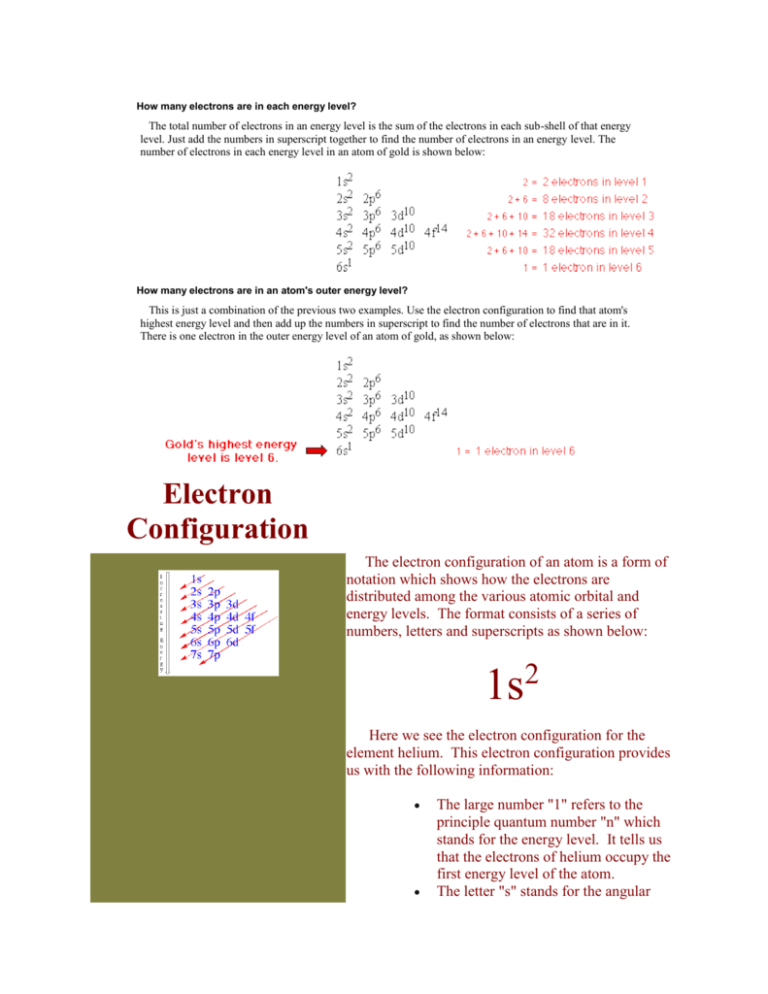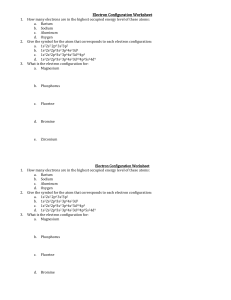How many electrons are in each energy level
advertisement

How many electrons are in each energy level? The total number of electrons in an energy level is the sum of the electrons in each sub-shell of that energy level. Just add the numbers in superscript together to find the number of electrons in an energy level. The number of electrons in each energy level in an atom of gold is shown below: How many electrons are in an atom's outer energy level? This is just a combination of the previous two examples. Use the electron configuration to find that atom's highest energy level and then add up the numbers in superscript to find the number of electrons that are in it. There is one electron in the outer energy level of an atom of gold, as shown below: Electron Configuration The electron configuration of an atom is a form of notation which shows how the electrons are distributed among the various atomic orbital and energy levels. The format consists of a series of numbers, letters and superscripts as shown below: 1s2 Here we see the electron configuration for the element helium. This electron configuration provides us with the following information: The large number "1" refers to the principle quantum number "n" which stands for the energy level. It tells us that the electrons of helium occupy the first energy level of the atom. The letter "s" stands for the angular Need More Help? momentum quantum number "l". It tells us that the two electrons of the helium electron occupy an "s" or spherical orbital. The exponent "2" refers to the total number of electrons in that orbital or sub-shell. In this case, we know that there are two electrons in the spherical orbital at the first energy level. Before we continue, we must review some information that you will need to fill in electron configurations correctly. I. Principle Quantum Number (n) and Sublevels The number of sublevels that an energy level can contain is equal to the principle quantum number of that level. So, for example, the second energy level would have two sublevels, and the third energy level would have three sublevels. The first sublevel is called an s sublevel. The second sublevel is called a p sublevel. The third sublevel is called a d sublevel and the fourth sublevel is called an f sublevel. Although energy levels that are higher than 4 would contain additional sublevels, these sublevels have not been named because no known atom in its ground state would have electrons that occupy them. II. Sublevels and Orbitals An orbital is a space that can be occupied by up to two electrons. Each type of sublevel holds a different number or orbitals, and therefore, a different number of electrons. s sublevels have one orbital, which can hold up to two electrons. p sublevels have three orbitals, each of which can hold 2 electrons, for a total of 6. d sublevels have 5 orbitals, for a possible total of 10 electrons. f sublevels, with 7 orbitals, can hold up to 14 electrons. The information about the sublevels is summarized in the table below: Table 3-6a - Orbital and Electron Capacity for the Four Named Sublevels Sublevel # of orbitals Maximum number of electrons s 1 2 p 3 6 d 5 10 f 7 14 III. Total Number of Orbital and Electrons per Energy Level An easy way to calculate the number of orbitals found in an energy level is to use the formula n2. For example, the third energy level (n=3) has a total of 32, or nine orbitals. This makes sense because we know that the third energy level would have 3 sublevels; an s sublevel with one orbital, a p sublevel with 3 orbitals and a d sublevel with 5 orbitals. 1 + 3 + 5 = 9, so the formula n2 works! IV. Total Number of Electrons per Energy Level An easy way to calculate the total number of electrons that can be held by a given energy level is to use the formula 2n2. For example, the fourth energy level (n=4) can hold 2(4)2 = 32 electrons. This makes sense because the fourth energy level would have four sublevels, one of each of the named types. The s sublevel hold 2 electrons, the p sublevel holds 6 electrons , the d sublevel holds 10 electrons and the f sublevel holds 14 electrons. 2 + 6 + 10 + 14 = 32, so the formula 2n2 works! We can summarize this information in the table below: Table 3-6b Orbitals and Electron Capacity of the First Four Principle Energy Levels Number Maximum Number Principle of number Type of of energy orbitals of sublevel orbitals level (n) per electrons per type level(n2) (2n2) 1 s 1 1 2 2 3 4 s 1 p 3 s 1 p 3 d 5 s 1 p 3 d 5 f 7 4 8 9 18 16 32 V. Order of Filling Sublevels with Electrons The next thing that you need to recall is the fact that the energy sublevels are filled in a specific order that is shown by the arrow diagram seen below: Remember to start at the beginning of each arrow, and then follow it all of the way to the end, filling in the sublevels that it passes through. In other words, the order for filling in the sublevels becomes; 1s, 2s, 2p, 3s, 3p, 4s, 3d, 4p, 5s, 4d, 5p, 6s, 4f, 5d, 6p, 7s, 5f, 6d,7p.







